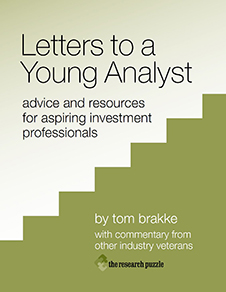
- Wednesday, May 6th, 2009
- from the ivory tower
-
I once sent a piece of academic research to a practitioner, because I thought the topic would be of great interest, since it dealt directly with the type of analysis performed by his firm. The response was basically, “Let’s see how the experts would fare trying to make decisions on these stocks.”
This posting begins a series (currently of indeterminate length) of postings on academic papers that I have found of interest of late. Prior to digging in, it makes sense to set the stage a bit.
I believe that investment puzzles should be looked at from a variety of different perspectives, including that found in analyses that we commonly lump within the rubric of “academic research.” The extent to which investors and investment firms pay attention to the flow of this research varies dramatically, with it being part and parcel of the process at many quant shops, but ignored entirely by many others, which I think is a mistake. There are insights to be found, although it’s a chore sometimes to find them.
Why? To begin with, there is the sheer volume of research that is produced. If you sign up for all of the relevant email notifications for working papers from the Social Science Research Network (SSRN)SSRN | This is the dominant provider of finance-related research. and other sources, you’ll soon be overwhelmed. Plus, different compilations of papers can feature the same piece of research (and various versions of one paper will show up as it’s modified over time), so managing the flow is a challenge. The current structure works best for professors who are following a narrow field of study (which is not surprising, since that’s who the service was primarily designed for), but less well for practitioners who are looking for nuggets of gold in the wide river of research.
In addition, the papers are written, as you might expect, for other professors. So, you’ll see shorthand references that might mean a great deal to someone immersed in the topic at hand, but that don’t work for the lay person. To those not statistically or mathematically inclined, entire sections and exhibits end up being in the proverbial Greek. Since working papers are just that and not final publication-ready pieces, you’ll find that quite a few of them could use the touch of a good editor. A great many would benefit from better illustrations and tables (something that I think is true for most published journals in the financial field as well).
Thankfully, by reading the abstracts you can often get a sense of whether the paper might be of interest, and the introduction and conclusion sections of them usually serve the purpose of indicating whether it is worthwhile to continue with a deep dive.
For those who want some exposure to interesting research without sifting through it themselves, there are a number of good sources. Of course, there are many journals that present peer-reviewed research, the end product of the give and take over the working papers.I don’t know enough about the process of peer review to comment on it. I wonder how often controversial or innovative research is rejected because of orthodoxy rather than concerns over data or analytical methods. Of course, the space in publications is limited, so it’s likely that a fair bit of interesting research goes unpublished. (As a point of reference, for its 2008 fiscal year, 267 manuscripts were submitted to the Financial Analysts Journal; nineteen were published.) In addition, there are others that provide commentary on working papers and published research on a regular basis.
Mark Hulbert features academic work in his Sunday column in the New York Times, while Paul Kedrosky periodically highlights research of interest on his website, Infectious Greed.Infectious Greed | Kedrosky has a super-wide frame of reference in all things, including academic research. For day-to-day analysis and commentary on worthwhile research, check out CXO Blog.CXO Advisory Group | There are regular summaries of papers of interest on this site in addition to review of the firm’s own analytical models (and analysis of the performance of “gurus,” among other things). Less frequent but very useful are the postings on the Empirical Finance Research Blog,Empirical Finance Research Blog | To the point of my piece, the subtitle of the site is “Wading through the mountains of empirical finance literature so you don’t have to…” This link is to a posting that reviews a piece of research on the behavior of prices following earnings announcements. since they are graded as to relevance for practitioners and include clear and concise information about the research and how it might be used.
With the preamble out of the way, let’s take a look at some recent research and see how we might use it to consider the investment issues at hand.
